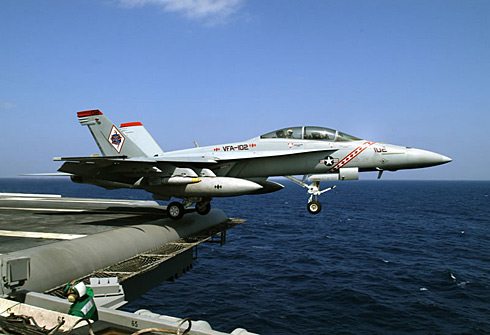There were no big surprises in President Obama’s announcement today of his new defense strategy. The President made a lot of promises in his brief address. “As commander in chief, I am determined that we meet the challenges of this moment responsibly and that we emerge even stronger in a manner that preserves American global leadership, maintains our military superiority and keeps faith with our troops, military families and veterans.”
Geo-strategically, the new strategy places greater emphasis on the Asia-Pacific theater. In addition, the new strategy does away with the force sizing metric of two Major Theatre Contingencies (MTCs), replacing it with winning one while being able to deny the objectives of or impose unacceptable costs on another aggressor.
According to Pentagon reporting, the new strategy will place particular emphasis on intelligence, surveillance and reconnaissance programs and counterterrorism capabilities, combating anti-access technologies, countering weapons of mass destruction and cyber warfare.
What does it all mean? Maintaining our military superiority while keeping faith with our troops, military families and veterans means preferring the investment and personnel accounts, specifically pay and benefits, over force structure and Operations and Maintenance. Changing the defense guidance away from being able to fight and win two MTCs means that the size of the U.S. military must shrink. To maintain critical investments and sustain the growth rates on military pay and benefits will require getting rid of people and older equipment. There are reports that the Army will be reduced to 490,000, about the same level it was a decade ago.
So who wins and who loses as a result of the new strategy? The biggest winners coming out of the new defense strategy are former Secretary of Defense Donald Rumsfeld, former Deputy Secretary of Defense Paul Wolfowitz, Richard Perle and the rest of the so-called neo-cons. It was they who saw the future: a need to focus on emerging competitors and threats such as China and Iran, the desirability of investing more in aerospace technologies that could transform the way the U.S. military would fight and put less emphasis on large land forces. This now appears to be the strategy the Obama Administration has chosen to pursue. Not much of what Rumsfeld and company put in place in 2001-2003 survived the twin conflicts in Iraq and Afghanistan, but there may yet be life after death.
The next biggest winner is rapid power projection forces and the capabilities to support them. If the U.S. military is going to be able to both fight and win one MTC and “spoil” another aggressor’s plans it will have to strike hard and fast, penetrating adversaries’ defenses and defeating their anti-access capabilities. This means, in particular, the nation will have a new strategic bomber, or as it is called the long-range strike family of systems. In addition, the military will need a range of new, more capable, even stealthy weapons systems. ISR investments will have to shift from non-stealthy platforms that provide endless hours of full motion video to less vulnerable systems that collect a myriad of types of information. The same platforms may also be able to engage in advance electronic combat. Also, look for continuing investments in space-based systems for both communications and ISR. Aircraft carriers, large amphibious ships and nuclear attack submarines all should increase in value. Add to these theater and homeland missile defenses to blunt a first strike and protect forward deployed forces, bases and allies.
A surprising winner may be the nuclear deterrent. There is a subtle change of tone in the new defense guidance with respect to the future of nuclear weapons. The phrasing now is that “it is possible that our deterrence goals can be achieved with a smaller nuclear force.” Sounds like there will be a substantial nuclear posture change in the Department of Defense’s future.
I think the Army could emerge from the current situation a winner. Yes, it will lose end-strength. It might even have to, perish the thought, furl some flags and let go some general officers. But for the first time in almost two decades the Army has the opportunity to sit back and think about how to conduct future wars. After a nearly unbroken record of failure in bringing major acquisition programs to fruition, it can go back to the drawing board when it comes to the kinds of future capabilities it will need and the science and technology investments to get them.
The biggest loser, and deservedly so, is counter-insurgency. This concept was a loser from day one, requiring too many forces and costing too much money. Moreover, as Iraq is already demonstrating, the probability of success is not good.
Another likely big loser is the defense industrial base, both the public and private halves. The defense department spends some $200 billion a year on services; expect this area to come under enormous pressure as the search for savings intensifies. In addition, the Pentagon will have to seek another round of base closures. The major defense companies, those that oversee the building of major platforms and weapons systems will probably do okay. However, below that level, it may be a bloodbath.
It is not clear from the new defense strategy what is to become of the Marine Corps or more specifically its raison de guerre, large-scale amphibious operations. There have been suggestions in the past that Pentagon leaders were reconsidering the need for a large-scale capability to cross a hostile beach. Without the amphibious warfare mission, the Corps could get significantly smaller. There would be additional savings in shipbuilding. The new strategy gives no indication that the administration intends to go in this direction.
Overall, the new strategy is still one of champagne tastes on a beer budget. It requires the U.S. military to be capable of too many missions and to do too many things. While it proposes being more judicious in our choices of where, when and how to intervene abroad, no administration has demonstrated any self-discipline in this area. We have 100 U.S. soldiers in Uganda. If we cannot even see our way clear to leaving the Lord’s Resistance Army unmolested, where won’t we go and who won’t we fight?











